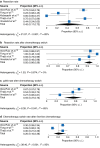Chemotherapy switch for localized pancreatic cancer: a systematic review and meta-analysis
- PMID: 39400008
- PMCID: PMC11472162
- DOI: 10.1093/bjs/znae244
Chemotherapy switch for localized pancreatic cancer: a systematic review and meta-analysis
Abstract
Background: Patients with localized (that is non-metastatic) pancreatic ductal adenocarcinoma with an inadequate response or toxicity to first-line chemotherapy may benefit from chemotherapy switch. The aim was to explore the available data on the use and effect of chemotherapy switch, as reported in the literature.
Methods: A systematic search was conducted in Embase, MEDLINE (Ovid), the Web of Science, Cochrane, and Google Scholar on 1 December 2023. The main outcomes were the proportion of patients who underwent chemotherapy switch and the carbohydrate antigen 19-9 response and resection, R0 resection, and ypN0 resection rates after chemotherapy switch. Data were pooled using a random-effects model.
Results: A total of five retrospective studies, representing 863 patients with localized pancreatic ductal adenocarcinoma, were included and 226 of the 863 patients underwent chemotherapy switch. In four studies, first-line chemotherapy consisted of 5-fluorouracil/leucovorin/irinotecan with oxaliplatin ('FOLFIRINOX') and patients were switched to gemcitabine with nab-paclitaxel. Reasons for chemotherapy switch included an inadequate biochemical, clinical, or radiological response, or toxicity. Three studies compared patients who underwent chemotherapy switch with patients who only received first-line chemotherapy and found that the proportion of patients who underwent chemotherapy switch was 20.5% (95% c.i. 10.5% to 36.3%). The pooled resection rate after chemotherapy switch was 42.0% (95% c.i. 16.6% to 72.5%). Two studies compared the chance of resection after chemotherapy switch versus first-line chemotherapy alone and found a risk ratio of 0.88 (95% c.i. 0.65 to 1.18). Two studies, with a combined total of 576 patients, found similar postoperative survival for patients who underwent chemotherapy switch and patients who only received first-line chemotherapy.
Conclusion: One in five patients with localized pancreatic ductal adenocarcinoma underwent chemotherapy switch after an inadequate response or toxicity to first-line chemotherapy. The pooled resection rate after chemotherapy switch was 42% and similar in overall survival compared with first-line chemotherapy only. Three ongoing trials are investigating chemotherapy switch in patients with an inadequate radiological or carbohydrate antigen 19-9 response.
© The Author(s) 2024. Published by Oxford University Press on behalf of BJS Foundation Ltd.
Figures

References
-
- Siegel RL, Giaquinto AN, Jemal A. Cancer statistics, 2024. CA Cancer J Clin 2024;74:12–49 - PubMed
-
- National Comprehensive Cancer Network (NCCN) . NCCN Clinical Practice Guidelines in Oncology: Pancreatic Adenocarcinoma (Version 1.2024). https://www.nccn.org/professionals/physician_gls/pdf/pancreatic.pdf (accessed 19 December 2023)
-
- Strobel O, Neoptolemos J, Jäger D, Büchler MW. Optimizing the outcomes of pancreatic cancer surgery. Nat Rev Clin Oncol 2019;16:11–26 - PubMed
-
- Springfeld C, Ferrone CR, Katz MHG, Philip PA, Hong TS, Hackert T et al. Neoadjuvant therapy for pancreatic cancer. Nat Rev Clin Oncol 2023;20:318–337 - PubMed
Publication types
MeSH terms
Substances
Grants and funding
LinkOut - more resources
Full Text Sources
Medical

